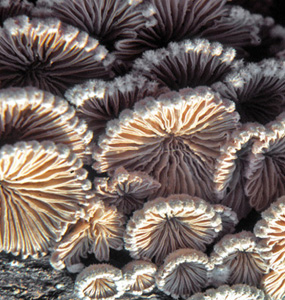Schizophyllum commune

Image Courtesy of Peter Katsaros
| Click to Enlarge |
| Click For Image Gallery |
|
Group of Fungi: Polypores Family: Schizophyllaceae Latin Name: Schizophyllum commune Fr. Common Name: Common Split-gill Description: Fan-shaped to shell-shaped structure, cap 3/8–1 5/8 in (1–4 cm) across and up to 1/8 in (0.3 cm) thick, concave to almost flat, tough and leathery; upper surface densely hairy, light grayish-brown when moist, ashy grey to white when dry; margin lobed, wavy, densely hairy; spore-bearing surface consisting of well-spaced, longitudinally split gill-like structures, light grey; stalk lacking or rudimentary; spores white in mass. Biological Role: Decomposer of decaying wood. Habitat: On fallen branches and wood debris of broadleaf trees; solitary or occurring in small groups, the individual fruiting bodies sometimes fused and often overlapping. Geographical Distribution: Found throughout North America but relatively more common in the east. Comments: Schizophyllum commune is an unusual fungus that appears to have gills but is not closely related to the agarics. It is grouped with the polypores on this website because of its general appearance and usual habitat. This fungus is much too small and tough to be considered for human consumption. |
| Go Back |